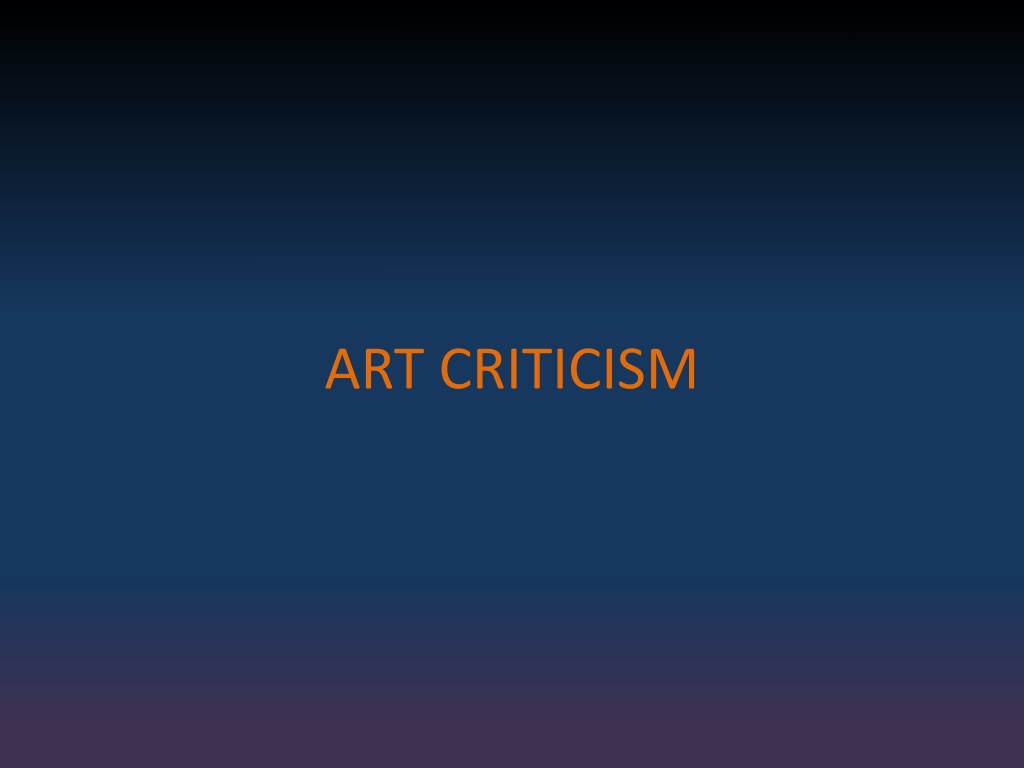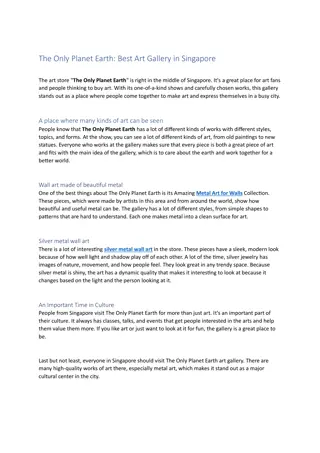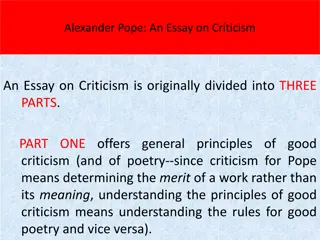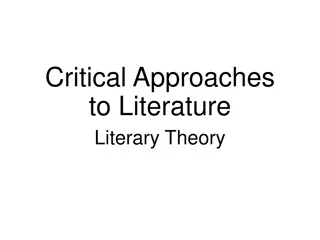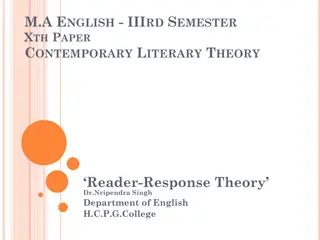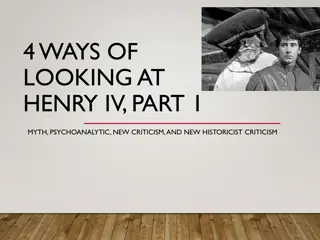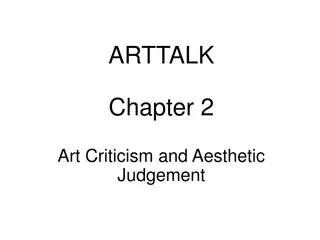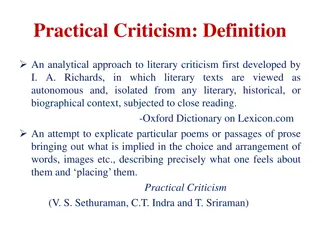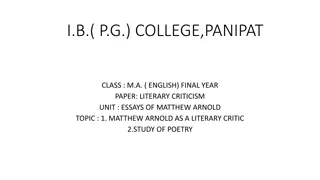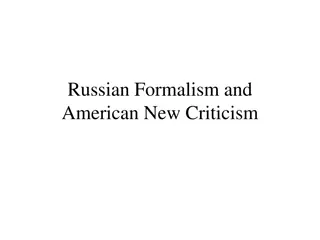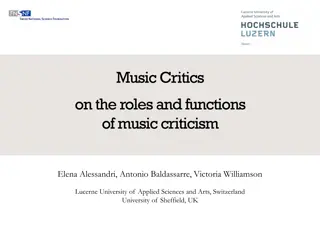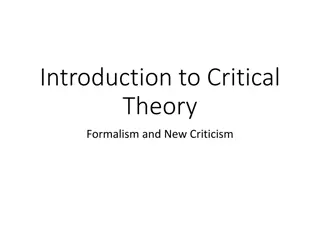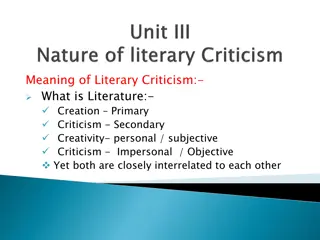Understanding Art Criticism: A Comprehensive Guide
Delve into the realm of art criticism to grasp the essence of responding to, interpreting, and making critical judgments about artworks. Explore the steps of art criticism, from description to judgment, and learn how to analyze artworks in terms of elements and principles of art and design.
Download Presentation

Please find below an Image/Link to download the presentation.
The content on the website is provided AS IS for your information and personal use only. It may not be sold, licensed, or shared on other websites without obtaining consent from the author. Download presentation by click this link. If you encounter any issues during the download, it is possible that the publisher has removed the file from their server.
E N D
Presentation Transcript
ART APPRECIATION & ART CRITICISM Art critics usually criticize art in the context of aesthetics or the theory of beauty. Art criticism is responding to, interpreting meaning, and making critical judgments about specific works of art. One of criticism's goals is the pursuit of a rational basis for art appreciation.
According to Edmund Burke Feldman (1980), there are four steps of art criticism. Description Analysis Interpretation Judgement
Detail observation to recognize the subject in the artworks. What do I see? Size & media Date & title There are two types of subject, which is non- objective subject matter and objective subject matter.
What do you see? Describe the artwork in terms of what can be seen. Include sensory elements of color, line, texture, shape and space. Take into account the title, artist, date created, size, subject matter, materials used and presentation. What is the name of the artist who created the artwork? What kind of an artwork is it? What is the name of the artwork? When was the artwork created? List the literal objects in the painting (trees, people, animals, mountains, etc.). What do you notice first when you look at the artwork? Are people shown to you? What are they doing? Is a time, place or event shown? What time of day/night is it? What kind of colors, shapes, lines and textures has the artist used? Describe them. Where do you see them?
To relate the sign with the element and principle of art and design. How is the work organized? To discover the whole ideas that being organize or composition. The elements of art and design include lines, shape, form, texture, space, tone, and color. The principle of art and design, which is balance, harmony, unity, contrast, repetition and dominance.
How is the work organized? Analyze how the parts you see and have described are arranged and work together, thinking in terms of textures, shapes/ forms, light/ dark or bright/dull colors, types of lines, and sensory qualities. In this step consider the most significant art principles that were used in the artwork. Describe how the artist used them to organize the elements. Suggested questions to help with analysis: How has the artist used colors in the artwork? What sort of effect do the colors have on the artwork? How the artist used shapes within the work of art? How have lines been used in the artwork? Has the artist used them as an important or dominant part of the work, or do they play a different roll? What role does texture play in the artwork? Has the artist used the illusion of texture or has the artist used actual texture? How has texture been used within the artwork? How has the artist used light in the artwork? Is there the illusion of a scene with lights and shadows, or does the artist use light and dark values in a more abstracted way? Is there distance created in this picture? Is there a foreground, a middle ground and a background? What visual tricks has the artist used to create the feeling of distance? How has the overall visual effect or mood of the artwork been achieved by the use of elements of art and principles of design?
To described and find the meaning or mood of the artworks. What is the artist saying? Assumption must be tested and judge by the evidence of visual sign. We used our experience to find, explore, the meaning of mood or ambience of the artists. To combine the imagination, expertise and creative value to search the sign of visual arts and relate the meaning with the artworks.
What does it mean? An interpretation seeks to explain the meaning of the work based on what you have learned so far about the artwork, what do you think the artist was trying to say? What was the artist s statement in this work? What do you think it means? Does it seem quiet? Happy? Powerful? Dreamy? What does it mean to you? How does this relate to you and your life? What feelings do you have when looking at this artwork? What are the main ideas, meanings and concepts? How are they presented? Are any of the following devices used? Allegory: a representation that illustrates a deeper meaning Symbol: a representation of something else Sign: a thing that stands for something else Iconography: an identifying subject matter Why do you think that the artist chose to work in this manner and made these kinds of artistic decisions? Why did the artist create this artwork?
Did the artist use the formalistic elements to convey his message well? Do you think this is a successful work of art? The study of the similarities and differences Is it significant for the society?
Is it significant? What do you think of the artwork? After careful observation, analysis, and interpretation of an artwork, you are ready to make your own judgment. This is your personal evaluation based on the understandings of the artwork. Here are questions you might consider: Why do you think that this work has intrinsic value or worth? What is the value that you find in the artwork? (For example, it is a beautiful work of art, conveys an important social message, affects the way that you see the world, makes insightful connections, reaffirms a religious belief, etc.) Do you think that the artwork has a benefit for others? Do you find that the work communicates an idea, feeling or principle that would have value for others? How well does the art meet the interpretation? What kind of an effect do you think the work could have for others? Does the work lack value or worth? Why do you think this is so? Could the reason you find the work lacking come from a poor use of the elements of art? Could the subject matter by unappealing, unimaginative, or repulsive? Rather than seeing the work as being very effective or without total value, does the work fall somewhere in-between? Do you think that the work is just o.k.? What do you base this opinion on? The use of elements of art? Lack of personal expression? The work lacks a major focus? Explore your criticism of the artwork as much as you would any positive perceptions. Realize that your own tastes and prejudices may enter into your criticism. Give your positive and negative perceptions.
Art criticism can make the study art less mysterious and more logical. It is a sequential approach for looking at and talking about art. It will helped you to interpret works of art. It will give you confidence to discuss works of art without worrying about what other people might think. It will help you to organized your thoughts. Develop the courage to speak your mind and make sound aesthetic judgments.
Ahmad Fuad Osman Recollections of Long Lost Memories #1 Oil on canvas, 2007 244 x 366 cm
The Recollections of Long Lost Memories #1 is the latest art work from Ahmad Fuad Osman Recollections of Long Lost Memories series exhibition in Rimbun Dahan. The art work is a landscape format painting using oil medium on canvas. The painting was done in 2007. The images are uses in the painting are the image of Allahyarham Tunku Abdul Rahman and a teenager. The color that been use are monochromatic and bright colours. The late Allahyarham Tunku Abdul Rahman is wearing Baju Melayu with Sampin holding an umbrella where else the teenager is wearing the sunglasses on his head, a blue tee, jeans, sport shoes and dyed hair. The landscape of the painting pictures the river, mountains and trees. The artist uses the glazing technique in his painting. His style is pop art but using the realistic approach. The composition of the images is approximate balance. The color of the old picture of Allahyarham Tunku Abdul Rahman is the black and white monochromatic color. Where else, the teenager is in brighter colours. The colour of the late Tunku presents the past time but the unknown teenager shows the present. The landscape is portrays such in the kampong with a long wooden bridge. The teenager is from present standing in front the Tunku. The value or tone of colours can be seen in this painting where the light and shadow plays the roles to form the images. There are perceptible contrast between the two images in aspects of colours and characteristic. The late Tunku is a symbol of Malaysian heroes but the other image is unknown teenager with western appearances. The artist use deep space in this painting where we can see the mountain far from the human figures. There are many kind of line that been use in this artwork such as horizontal, vertical, diagonal and organic. The image of a teenager is dominance compare to the other images because of the colours. The positions of the two images create the movement like both walking crossing the river.
Recollection of long lost Memories #1 is in commemoration of the occasion of our nations 50th Merdeka last two years. The idea of reference the historic occasion and photos from the past came to Ahmad Fuad. He sees another person standing in front the late Tunku crossing the river. The person from the present is composing on the blank spaces in the old picture. He said that history is false memory . We don t get to influence history thus we don t care about it that much. The young Malaysians do not really understand the meaning of Merdeka. They only study the history in classroom and feel the Merdeka sanniversary in full of joy and happiness. Therefore they don t really care because they do not experience the hard time to gain the independence. This painting has achieves the issues of the young people that don t really care and understand the meaning to be independent. The youth in the painting wears modern dresses do not portrays the identity of Malaysia-ness compare to Allahyarham Tunku Abdul Rahman. It shows that the youth mind is still being colonized by the western culture. The painting translated the meaning of the independence not only in the historical perception but also the modernity of the present. By the idea of Fuad in this painting, he uses the images that integrated to each other which bring the meaningful expression and make the audience to think further. Image can serve as pictures, are as symbols; they can also be used as more signs Rudolph (1970)
